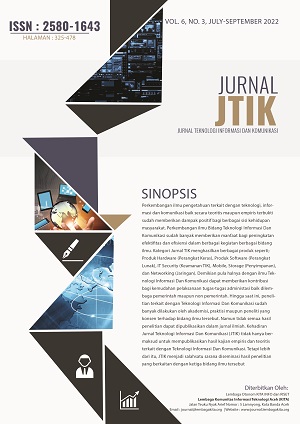Sistem Pakar Deteksi Dini Gejala Poliycystic Kidney Disease (PKD) Menggunakan Metode Forward Chaining Berbasis Android
DOI:
https://doi.org/10.35870/jtik.v6i3.413Keywords:
Expert System, Polycystic Kidney Disease, Forward Chaining Method, Android BasedAbstract
The purpose of this study is to build an application with the forward chaining method used to diagnose Polycystic Kidney Disease based on Android. The research method consists of analysis and design, while the use case diagram is used as a model of the system to be built, Forward Chaining is implemented in the system to diagnose Polycystic Kidney Disease and the application is built based on Android. The conclusion from the results of this study is to show the application features that are made to run. An expert system application designed to be able to help Polycystic Kidney Disease based on the symptoms entered by the user using the Forward Chaining method.
Downloads
References
Bergmann, C., Guay-Woodford, L.M., Harris, P.C., Horie, S., Peters, D.J. and Torres, V.E., 2018. Polycystic kidney disease. Nature reviews Disease primers, 4(1), pp.1-24.
Cornec-Le Gall, E., Alam, A. and Perrone, R.D., 2019. Autosomal dominant polycystic kidney disease. The Lancet, 393(10174), pp.919-935.
Cornec-Le Gall, E., Alam, A. and Perrone, R.D., 2019. Autosomal dominant polycystic kidney disease. The Lancet, 393(10174), pp.919-935.
Cornec-Le Gall, E., Alam, A. and Perrone, R.D., 2019. Autosomal dominant polycystic kidney disease. The Lancet, 393(10174), pp.919-935.
Serra, G., Corsello, G., Antona, V., D’Alessandro, M.M., Cassata, N., Cimador, M., Giuffrè, M., Schierz, I.A.M. and Piro, E., 2020. Autosomal recessive polycystic kidney disease: case report of a newborn with rare PKHD1 mutation, rapid renal enlargement and early fatal outcome. Italian journal of pediatrics, 46(1), pp.1-6.
Al-Qumboz, M.N.A., Elsharif, A.A., Samy, I.M.D. and Abu-Naser, S.S., 2019. Kidney Expert System Diseases and Symptoms. International Journal of Academic Engineering Research (IJAER), 3(5).
Singla, J., Kaur, B., Prashar, D., Jha, S., Joshi, G.P., Park, K., Tariq, U. and Seo, C., 2020. A Novel Fuzzy Logic-Based Medical Expert System for Diagnosis of Chronic Kidney Disease. Mobile Information Systems, 2020.
Soroka, S., Alam, A., Bevilacqua, M., Girard, L.P., Komenda, P., Loertscher, R., McFarlane, P., Pandeya, S., Tam, P. and Bichet, D.G., 2018. Updated Canadian expert consensus on assessing risk of disease progression and pharmacological management of autosomal dominant polycystic kidney disease. Canadian journal of kidney health and disease, 5, p.2054358118801589.
Kaur, B., Sadawarti, H. and Singla, J., 2019, November. A Comprehensive Review of Medical Expert Systems for Diagnosis of Chronic Kidney Diseases. In 2019 International Conference on Smart Systems and Inventive Technology (ICSSIT) (pp. 1008-1013). IEEE.
Abu Al-qumboz, M.N., Elsharif, A.A., Dheir, I.M. and Abu-Naser, S.S., 2019. Kidney Expert System Diseases and Symptoms.
Azhar, S., Sari, H.L. and Zulita, L.N., 2014. Sistem Pakar Penyakit Ginjal Pada Manusia Menggunakan Metode Forward Chaining. Jurnal Media Infotama, 10(1).
Jepri, J., 2019. Pengembangan Sistem Pakar Diagnosis Penyakit Ginjal Kronik Menggunakan Metode FIS-Sugeno. STRING (Satuan Tulisan Riset dan Inovasi Teknologi), 3(3), pp.258-266.
Rosmawanti, N. and Kusumawardhani, G.P., 2021. Model Sistem Pakar Diagnosa Penyakit Gagal Ginjal Menggunakan Metode Teorema Bayes. Jutisi: Jurnal Ilmiah Teknik Informatika dan Sistem Informasi, 9(3), pp.205-216.
Suryadibrata, A., 2014. Sistem pakar untuk memprediksi penyakit ginjal kronis menggunakan neural network (Doctoral dissertation, Universitas Multimedia Nusantara).
Downloads
Published
Issue
Section
License
Copyright (c) 2022 Jurnal JTIK (Jurnal Teknologi Informasi dan Komunikasi)

This work is licensed under a Creative Commons Attribution-NonCommercial 4.0 International License.
Copyright and Licensing Agreement
Authors who publish with this journal agree to the following terms:
1. Copyright Retention and Open Access License
- Authors retain full copyright of their work
- Authors grant the journal right of first publication under the Creative Commons Attribution 4.0 International License (CC BY 4.0)
- This license allows unrestricted use, distribution, and reproduction in any medium, provided the original work is properly cited
2. Rights Granted Under CC BY 4.0
Under this license, readers are free to:
- Share — copy and redistribute the material in any medium or format
- Adapt — remix, transform, and build upon the material for any purpose, including commercial use
- No additional restrictions — the licensor cannot revoke these freedoms as long as license terms are followed
3. Attribution Requirements
All uses must include:
- Proper citation of the original work
- Link to the Creative Commons license
- Indication if changes were made to the original work
- No suggestion that the licensor endorses the user or their use
4. Additional Distribution Rights
Authors may:
- Deposit the published version in institutional repositories
- Share through academic social networks
- Include in books, monographs, or other publications
- Post on personal or institutional websites
Requirement: All additional distributions must maintain the CC BY 4.0 license and proper attribution.
5. Self-Archiving and Pre-Print Sharing
Authors are encouraged to:
- Share pre-prints and post-prints online
- Deposit in subject-specific repositories (e.g., arXiv, bioRxiv)
- Engage in scholarly communication throughout the publication process
6. Open Access Commitment
This journal provides immediate open access to all content, supporting the global exchange of knowledge without financial, legal, or technical barriers.












